Roman Portraits
Roman die engravers (celators) were capable of highly artistic portraiture with some life like, others somewhat stylized but when they were at their best they occasionally created miniature masterpieces of Roman art. Sometimes when one looks at the entire coins one can get the impression portraits of some emperors are so similar they must be using a stock portrait, but when you see them presented as I have here with only the portrait having digitally removed all other parts of the coins, it becomes clear they are actually portraits of distinct people.
I hold the copyright all of the portrait images on this page, as I have extracted them from images of the coins I photographed and personally did the digital work on them. If you have a use for any of these images, please request permission to use them, letting me know how and where you intent to use them. I will nearly always give permission if the use is for a non-commercial use, especially if it is an educational use. If you need one for a commercial purpose, we can discuss it. In some cases I can provide much higher resolution copies of the images should such be required.
NERO CLAUDIUS DRUSUS
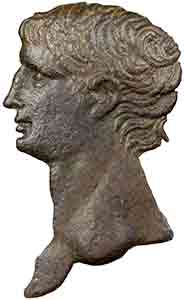 |
Nero Claudius Drusus was the younger brother of Tiberius and while never emperor himself he was an able general with several successful campaigns before dying at the age of only 29 follow a fall from a horse. He married Mark Antony's daughter Antonia who bore him two sons, Germanicus and the future emperor Claudius. All coins in his name were struck during the time of Claudius with this portrait taken from a sestertius struck at Rome during AD 41 to 42.
larger image
|
CLAUDIUS
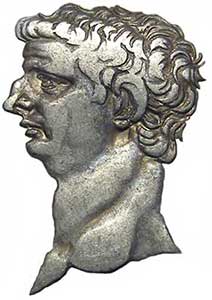 |
Tiberius Claudius Drusus, one of the most famous Roman emperors never wanted to be Emperor. On the assassination of Caligula he was forced onto the throne by the Praetorians who expected him to be their puppet but in the end he proved a very capable Emperor, ruling from AD 42 to 54. Having suffered infantile paralysis (polio?) he was deformed and said to have a grotesque appearance. While most of his coin struck at Rome show him idealized, this portrait from cistophorus struck at Ephesus has a more lifelike portrait probably close to how he actually looked.
larger image Colored image
|
VESPASIAN
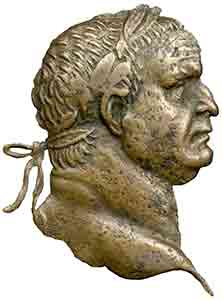 |
T. Flavius Vespasianus rose through the ranks to become a very distinguished officer, commanding Legion II Augusta during the invasion of Britain, at the age 34. In AD 66 he was given command of the eastern army to put down the Jewish revolt but soon after on the death of Nero the Empire was thrown into civil war in which Vespasian made his bid for the throne. He emerging victories by become Emperor in AD 69 and the following 10 years of his rule are considered one of the glory days of the Roman Empire. He was succeeded by his son's Titus and Domitian.
larger image
|
TRAJAN
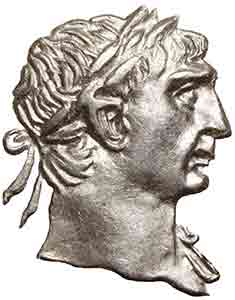 |
Marcus Ulpius Traianus was adopted by the weak ruler Nerva who needed a strong military leader has heir. Only four months later Nerva died and Trajan ascended to the throne. Trajan did not disappoint and his reign was one of expansion of the Empire with annexation of Dacia and creation of the province of Arabia, but his main goal of conquering Parthia was never completed. He died without heir on the 8th of August in 117, one of the few Roman Emperors to die of natural causes.
larger image
|
ANTONINUS PIUS
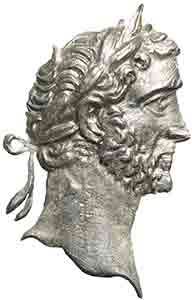 |
Born Titus Aurelius Fulvus Boionius Arrius Antoninus, after a distinguished career in many offices and ranks, he was adopted as the heir of Hadrian after the death of Aelius. On Hadrian's death in AD 138 he became Emperor and ruled through twenty three years of relative peace and prosperity in the Empire. Following the wishes of Hadrian, Antoninus Pius adopted Marcus Aurelius as he heir, although he also adopted Lucius Verus as joint heir at the same time, both of whom became Emperor on Pius' death in AD 161.
larger image
|
LUCIUS VERUS
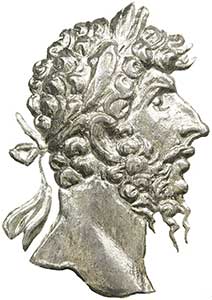 |
Born Lucius Ceionius Commodus, son of Aelius, after his adoption by Antoninus Pius he was later known as Lucius Aurelius. On the death of Pius in AD 161 Marcus Aurelius became Emperor but almost immediately made was made Verus co-emperor. Verus proved a poor and unpopular ruler who was not greatly missed after his premature death in AD 169.
larger image
|
CLODIUS ALBINUS
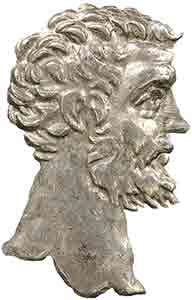 |
Clodius Albinus had a long and distinguished career military and political career under Marcus Aurelius and Commodus. When Septimius Severus was preparing for war with Pescennius Niger in the east, he elevated Clodius Albinus to the rank of Caesar, promising to make him his heir. In AD 194, as Severus elevated Caracalla to Caesar, Clodius Albinus realized he would never be heir so rebelled and went to Britain where is declared himself emperor. Soon after he was defeated and killed by the overwhelming forces of Septimius Severus.
larger image
|
SEPTIMIUS SEVERUS
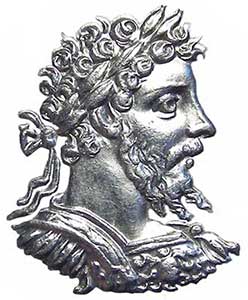 |
Lucius Septimius Severus was one of the great Roman generals and was loyal to Pertinax. When Pertinax was murdered in AD 193 he was proclaimed Emperor by his troops and was eventually the victor in the civil war of AD 293. The Empire was stable under his rule, but it was short lived, ending with his death in 211 as his some Caracalla became sole Emperor. This portrait is from a silver tetradrachm minted at Laodicaea ad Mare in Syria, showing him at the height of his military splendor and is a master piece of the Roman celators art.
larger image
|
CARACALLA
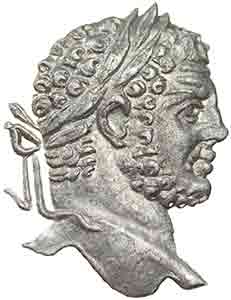 |
Septimius Bassianus, eldest son of Septimius Severus and Julia Domna, was born in AD 188. The name we know him by of Caracalla was a nickname referring to the Gallic hooded cloak he preferred to wear. In AD 195 name was changed to Marcus Aurelius Antoninus as a presence claiming to be of the family line of the Antonines. Both Caracalla and his younger brother Geta were raised to Caesar in AD 195, but only Caracalla was elevated to Augustus in AD 198. In AD 209 Geta was also elevated to Augustus, but on the death of Septimius in AD 211, Caracalla had Geta murdered in order to become sole emperor. History records Caracalla as a cruel ruler, and his later portraiture seems to reflect.
larger image
|
GETA
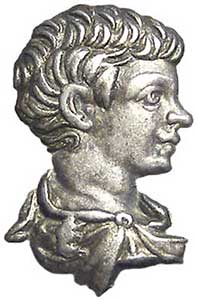 |
Septimius Geta, the younger son of Septimius Severus and Julia Domna, was raised to Caesar in AD 198 at the same time as his brother Caracalla. In AD 209 he was raised to Augustus and thus co-Emperor with Septimius Severus and Caracalla, but on the death of Severus In AD 211 Caracalla had no intention of sharing power and had Geta murdered.
larger image Colored image
|
Macrinus
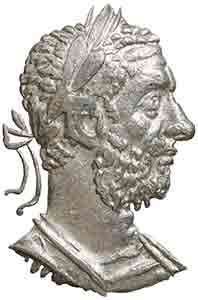 |
Marcus Opellius Macrinus was appointed Caracalla's praetorian in AD 212. Fearing Caracalla, probably with good reason, he arranged Caracalla's murder on the 8th of April AD 217, and was proclaimed Emperor by his troops and soon recognized by the Senate as the first Emperor not of Senatorial rank. He immediately raised his son Diadumenian to Caesar. In June of 218 Macrinus suffered a defeat near Antioch largely due to forces loyal to Julia Maesa, and was executed trying to flee west. His entire 14 month reign was spent in the east and he never entered Rome as Emperor.
larger image
|
Diadumenian
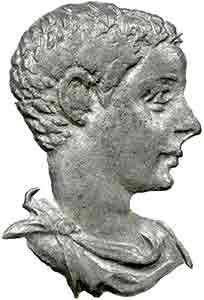 |
Marcus Opellius Diadumenianus was appointed to the rank of Caesar at the age of 9 in mid April of AD 217. Just over a year later, about mid May of 218, he was elevated to Augustus becoming co-emperor with his father, Macrinus. With in a month they were defeated by Elagabalus and while Macrinus fled west, Diadumenian was sent east with the hope he would be safe in the Parthian court, but both were soon captured and killed.
larger image
|
MAXIMINUS, THRAX
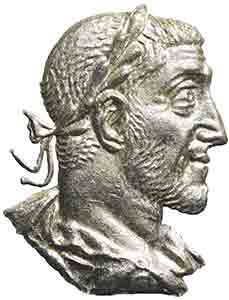 |
C. Julius Verus Maximinus was a huge man, possibly seven feet tall. Born a Thracian peasant he rose through the ranks of the army and was at one point governor of Mesopotamia. In AD 235 the army was dissatisfied with Severus Alexander whom they killing, proclaiming Maximinus Emperor. Hated by the nobility and not fully accepted by the senate, in AD 238 the Senate proclaimed Balbinus and Pupienus co-emperors to oppose him. Maximinus set out to invade Italy but he and his son Diadumenian were murdered by their own troops on June 24 of 238.
larger image
|
PAULINA
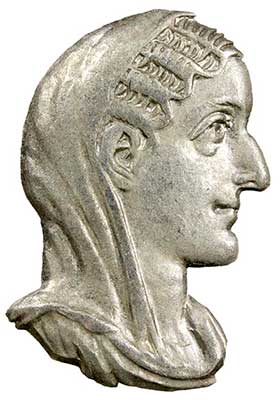 |
Paulina, wife of Maximinus Thrax and mother of Maximus, died either before or just as Maximinus was declared emperor. The histories little about her and it is only from the coins commemorating her after he death that we know of her.
larger image Colored image
|
MAXIMUS
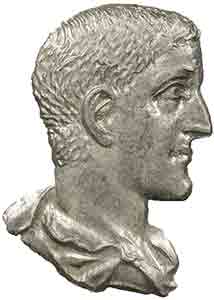 |
C. Julius Verus Maximus was the son of Maximianus and Paulina. Elevated to the rank of Caesar some time late in AD 235 to early 236 while probably in his late teens or early 20's, he was killed along side with his father at the siege of Aquileia June of AD 238 without having been promoted to Augustus.
larger image
|
GORDIAN III
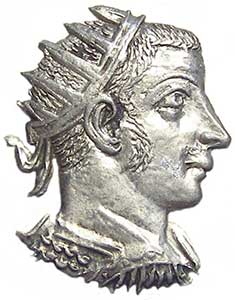 |
Marcus Antonius Gordianus was born to a daughter of Gordian I and later adopted by Balbinus and Pupienus as their heir to the throne. When they were killed by the Praetorian Guard in July of AD 238, the 13 year old Gordian III was thrust onto the throne with an expectation he would be a puppet controlled by the Praetorians. In AD 242 he married Tranquillina, daughter of the Praetorian Prefect C. Furius Sabinus Aquila Timesitheus but Timesitheus died a year later and replaced by a new prefect, Philip the Arab. With his own ambitions to the throne Philip has Gordian killed in AD 244. Gordian was enormously wealthy when he came to the throne, which might explain why his silver coinage is probably the most prolific of the entire Roman series.
larger image
|
PHILIP THE ARAB
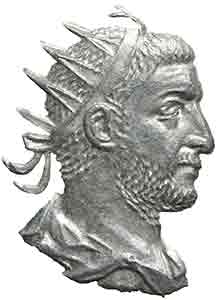 |
Marcus Julius Philippus was born in Arabia Trachonitis to an Arab chieftain. He worked his way up through the army until appointed Praetorian prefect in AD 244 at while point he deposed of Gordian III and had himself proclaimed Emperor. Most of his rule involved wars in Arabia and German plus rebellions against him in Moesia, Cappadocia and Syria. Philip and his son were killed in a battle near Verona when one of his own generals, Trajan Decius, marched against him in September of AD 249. A highlight of Philip's reign occurred in AD 247 when Rome celebrated it's 1000th anniversary of it's founding, for which an interesting series of commemorative coins were issued.
larger image
|
PHILIP II, SON OF PHILIP THE ARAB.
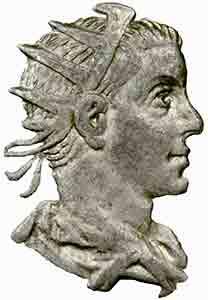 |
Marcus Julius Severus Philippus, commonly known as Philip II was the son of Philip I and Otacilia Severa. Born in AD 237 he was only 7 years old he was given the rank of Caesar when in AD 244 his father murdered Gordian III and declared himself Emperor. In AD 247 he was raised to the rank of Augustus as Co-emperor with Philip I, then in AD 249 at the age of 12 he and his father were at the battle of Verona against Trajanus Decius where his father was killed and he was captured and taken back to Rome where he was executed. This coin was struck in AD 246 when he was 9 years old.
larger image
|
Trajan Decius
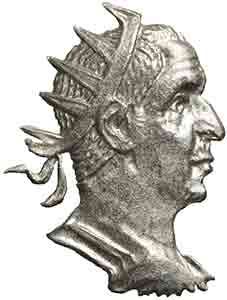 |
Gaius Messius Quintus Decius was a Pannonian who achieved senatorial rank, and may have held several high positions including governorships, but his history is not fully recorded. He was given command of the Danubian legions and after a successful campaign against the Goths in AD 249 proclaimed Emperor by his troops. This was something he did not want and was reluctant to accept, but in the end he did and marched against Philip the Arab, defeating and killing Philip in a battle near Verona. He was accepted by the Senate at which time he was given the name of Trajan. The Goths and the Carpi again invaded and Trajan Decius was killed in battle while defending Thrace in AD 251, the first Emperor to actually die in battle against a foreign enemy.
larger image
|
AEMILIAN
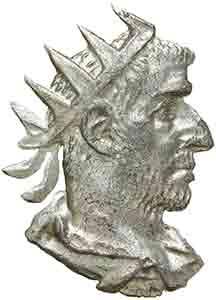 |
Marcus Amelius Aemilianus rose to power later in AD 253 when his troops proclaimed him Emperor in opposition to Tebonianus Gallus and Volusian. Believing Aemilian's army to be superior, Gallus and Volusian were murdered by their own troops allowing Aemilian entered Rome without a battle to be officially recognized by the Senate. Gallus and Volusian had appealed to Valerian for aid which was sent but arrived too late to save them. Facing Valerian's superior army, Aemilian was in turn murdered by his own troops, having been Emperor for a few months. Aemilian's coinage is today fairly scarce.
larger image
|
Tetricus I
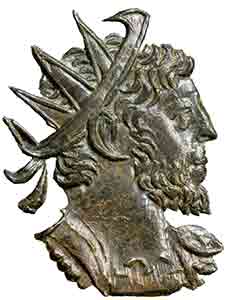 |
Gaius Pius Esuvius Tetricus came to the throne of the Gallic Empire in the autumn of AD 271 following the assassination of Victorinus. The Gallic Empire was by now in decline and Tetricus probably knew he could not win when Aurelian came to re-unify the Empire. In the spring of AD 274 Tetricus was defeated by Aurelian at the battle of Chalons-sur-Marne but was allowed to surrender and live his remaining days in Rome. This was unusual as winning Emperors normally killed their rivals, suggesting they already had some type of plan in place. Tetricus' coins are today common and nearly always found in relatively high grade, showing they did not circulate long after his defeat.
larger image
|
SEVERINA
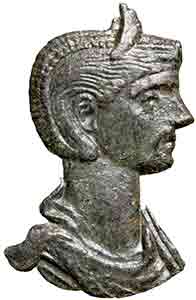 |
Ulpia Severina, wife of Aurelian, is not well recorded in the histories. She became Augusta late in Aurelian's reign, survived his assassination and continued to have coins in her name issued for a few more months. She lived out a natural life and was honored by Aurelian's successors. .
larger image
|
TACITUS
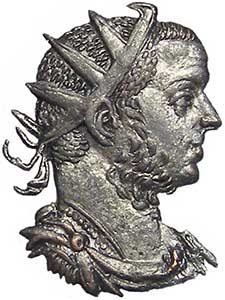 |
Tacitus ruled Rome from AD 275 to 276. He was 75 years old when proclaimed Emperor by the Senate following the assassination of Aurelian, an act in which he played no part. He immediately took to the field to command the Thracian army against a Gothic invasion of Asia Minor but the effort was too much for him and he died while still in Asian Minor.
larger image
|
PROBUS
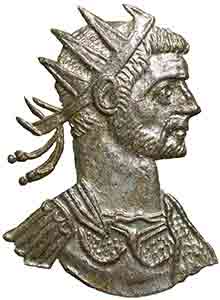 |
Probus rose through the ranks of the army to become on of Rome's top generals. On the death of Tacitus as the Senate recognized Florian as the new emperor, Probus was proclaimed Emperor by his troops in AD 272. He marched on Florian who was then killed by his own troops. Probus returned to Rome where the Senate recognized him as Emperor but his reign was fraught with usurpers and rebellions which he was able to put down, but he was harsh on his troops leading to a military revolt during which he was killed in AD 276.
larger image
|
CARINUS
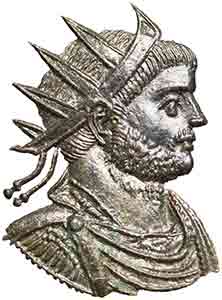 |
Marcus Aurelius Carinus was the eldest son of Carus, brother to Numerian. He was elevated to Caesar in October of AD 282, then to Augustus as co-emperor with Carus around the end of February or beginning of March in AD 283. For a few months Carus, Carinus and Numerian ruled as co-emperors but in July or August of AD 283 Carus was murdered, mostly likely by his praetorian prefect Arrius Aper. A year later Numerian was found dead, likely also a victim of Arrius Aper. Carinus was now the sole Emperor but was immediately challenged by two rebels, Julian of Pannonia whom he quickly defeated and killed, and Diocles a general proclaimed Augustus by Numerian's troops. A brief civil war ensued ending when Carinus was murdered by one of his own officers leaving Diocles in power.
larger image
|
NIGRINIAN
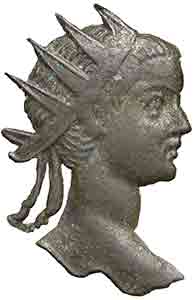 |
Little is known about Nigrinian other than he was the grandson of Carus, and was most likely the son of Carinus and Magnia Urbica. The coins struck to commemorate his consecration after his death show him as more a teenager, but it is more likely he died in infancy and his age is exaggerated on the coins.
larger image
|
JULIAN I, OF PANNONIA
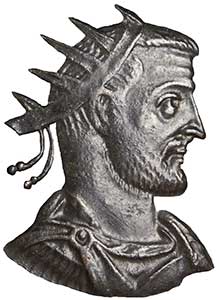 |
Marcus Aurelius Julianus was a general and governor of Venetia in northern Italy. On the death of Numerian in the fall of AD 284, Julian was proclaimed Emperor by the army of Pannonia as they were unhappy with the prospect of Carinus as Emperor. Carinus moved on him in February of AD 285 and Julian was killed in the ensuing battle near Verona. Julian who rebelled again Carinus in AD 284. He declared himself Emperor and marched his army against Rome, but when the two armies clashed near Verona early AD 285 Julian was defeated and killed.
larger image
|
ALLECTUS
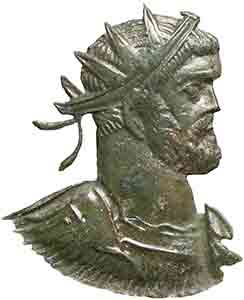 |
Allectus' full name is not known. He came to the throne of the rebel empire in Britain on the assassination of Carausius sometime in the spring or summer of AD 293, and most likely having been involved in the assassination. During the nearly three years Constantius Chlorus prepared to invade England, Allectus built fortification at London but miss-calculated on hearing Constantius' invasion force had landed near Hampshire and set out to do battle. He did not realize it was a two pronged landing with another large force landed at Kent. Allectus was killed during the battle near Hampshire while the other force moved into London and consolidated control, bringing Britain back under Roman control.
larger image
|
MAXIMIANUS, HERCULES
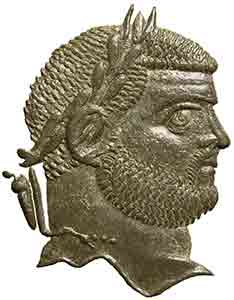 |
Marcus Aurelius Valerius Maximianus worked his way up through the army and as a close friend to Diocletian who raised him to the rank of Caesar in AD 285 and then in AD 286 to Augustus in charge of the western empire when Diocletian realized the empire was too large for one man to administer. This was a turbulent time during which Maximianus had many military successes but in AD 305 Diocletian reluctantly requested he abdicate in favour of Constantius, which is did reluctantly. The period that followed was even more turbulent with the death of Constantius and rise of some usurpers, so in AD 306 Maximianus was invited back for his second reign as Augustus. He forced to abdicated again in AD 308, but in AD 310 he usurped power for his third term as Augustus which only lasted a few months when he was defeated and probably committed suicide. One of only a handful of Emperors to abdicate and the only one to do so twice, he is also the only Emperor to be proclaimed Augustus three times.
larger image
|
MAXENTIUS
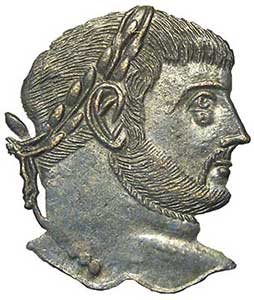 |
Marcus Aurelius Maxentius was the son of Maximianus with whom he does not appear to have been on good terms. Maximianus refused to promote Maxentius to the rank of Caesar and Maxentius only came to power in AD 307 through rebellion during Maximianus first abdication. Lacking the military strength needed to hold power Maxentius asked Maximianus to join him, which he did just to get back into power, which brought in recruits loyal Maximianus. They had another falling out with Maximianus joining with Constantine. This did not work out well for either of them with Maxentius soon declared to public enemy and Maximianus again forced to abdicate. A final battle between Maxentius and Constantine ensued and when defeated Maxentius attempted to escape by swimming a river but drown in the attempt.
larger image Colored image
|
GALERIUS
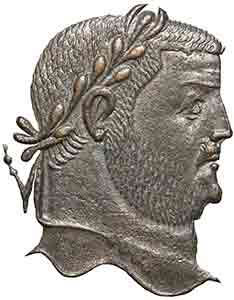 |
Gaius Galerius Valerius Maximianus started out a herdsman but joined the army and rise through the ranks to praetorian prefect under Diocletian. In March of 293 Diocletian appointed him Caesar in the Eastern Empire. He had many military victories including an important one over the Sassanids in AD 298. On the joint abdication of Diocletian and Maximianus in AD 305 he was elevated to Augustus in the east. On the death of Constantius I in AD 306 he became senior Augustus. The rest of his reign was very turbulent with many rivals including Maxentius, Constantius and Constantine. The politics of the period were complex but remained in power but in 310 he became seriously ill, dying May 5th of 311. He was anti-Christian and likely responsible for Christian persecutions, but a few days before he died he issued an edict ending those persecutions.
larger image
|
MAGNENTIUS
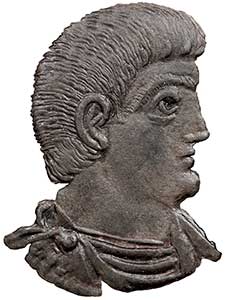 |
Magnentius was proclaimed Emperor of the Western provinces by his troops at Augustodunum on January 18th AD 350, usurping power from the unpopular Constans who was soon after murdered by Magnentius supporters. First establishing his hold over the west, he moved his army east as far as Sirmium, but after a series of battles against forces loyal to Constantius II he suffered a major defeat in the battle of Mursa Major, on the 28th of September 351. By mid 352 he could no longer control Italy and was slowly driven back to Gaul where he committed suicide on the 10th of August, 353.
larger image
|
NEPOTIAN
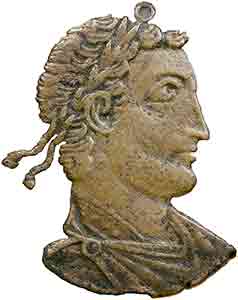 |
Nepotian was the nephew of Constantine the Great, son of his sister Eutropia. He lead a revolt against Magnentius, possibly with a Gladiator army as he had no command of regular troops. His revolt was centered only on Rome where he held control for only 28 days until killed by the forces of Magnentius. For this portrait I have taken the liberty of removing a few dark toning spots on the cheek.
larger image Colored image
|
JULIAN II, THE APOSTATE
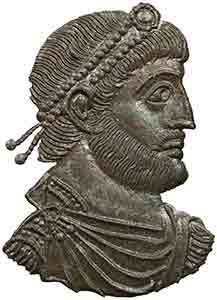 |
Flavius Claudius Julianus was a half-brother of Constantius Gallus and cousin of Nepotian, all three of which were descended from Constantius I and Theodora. As very young children, they were spared when in AD 337 nearly descendants of Constantius I and Theodora were massacred following the death Constantine the Great and to secure the expected line of the sons of Constantine the Great. In 354 Julian was raised to the rank of Caesar and sent to control Gaul, only because Constantius II had few other relatives left to call on but even then Constantius II attempted to restrict Julian's power, going so far as to refuse to send the funds needed to pay Julian's troops who in AD 360 mutinied proclaiming Julian Emperor. In AD 361 Constantius II died and Julian was official recognized as Emperor. It was not lost Julian that his older relatives had been massacred by the Christian line of Constantine so he rejected Christianity in favor of the old pagan religion. In AD 363 Julian was killed in battle against the Sassanids, although there is suspicion one of his Christian officers may have been responsible.
larger image
|
|



